After reading more than the average beginner reads (I've bought four books & checked out 7 from Library...plus the internet), I realize that it may take a long time before I can custom design my own amplifier and build it (possibly years). That said however, I wanted to get your initial thoughts on what I currently imagine my final ultimate amp design will end up being (just an abbreviated summary of some specs).
1) 75 watt monoblock (75 per amp for 75 per channel)
2) push pull triode mode ( $1,000 allocated per block for output tubes)
3) 10Hz to 40Khz +/- 1 db
4) high signal to noise
5) Class A
6) toroidal power supply
So I'd love to get your initial thoughts on my long term goal. I know that I have many short term goals to achieve before I get there but your thoughts will probably help me adjust the beginning part of the quest/journey. In other words, I might be very far from Taiwan or Peru but to increase my chances of ever arriving at one of those countries, my first steps will depend on which country I'm heading towards.
I'm an extreme reader and it makes my journey different than some of my friends who learn better by diving in first. We're all different and I feel like I do better in complex projects if I read a lot first.
Your thoughts are valued and closely considered.
kind thanks
Eddie
1) 75 watt monoblock (75 per amp for 75 per channel)
2) push pull triode mode ( $1,000 allocated per block for output tubes)
3) 10Hz to 40Khz +/- 1 db
4) high signal to noise
5) Class A
6) toroidal power supply
So I'd love to get your initial thoughts on my long term goal. I know that I have many short term goals to achieve before I get there but your thoughts will probably help me adjust the beginning part of the quest/journey. In other words, I might be very far from Taiwan or Peru but to increase my chances of ever arriving at one of those countries, my first steps will depend on which country I'm heading towards.
I'm an extreme reader and it makes my journey different than some of my friends who learn better by diving in first. We're all different and I feel like I do better in complex projects if I read a lot first.
Your thoughts are valued and closely considered.
kind thanks
Eddie
The 75 W. part is relatively easy. Use PP Class "AB2" KT88s in either UL or full pentode mode. Tubelab's PowerDrive is what you use to take the KT88s into a mild positive grid current regime. Blocking distortion is prevented by this kind of circuitry. 
Class "A" PPP triodes will give you all sorts of grief. Tube matching, current hogging, driver circuitry difficulty, and HEAT are some of the problems to be resolved.
Check out the offerings of AnTek, as a source of affordable toroidal power transformers.
BTW, bandwidth down to 10 Hz. is (IMO) not a good idea. LP warp noise lies there.
Class "A" PPP triodes will give you all sorts of grief. Tube matching, current hogging, driver circuitry difficulty, and HEAT are some of the problems to be resolved.
Check out the offerings of AnTek, as a source of affordable toroidal power transformers.
BTW, bandwidth down to 10 Hz. is (IMO) not a good idea. LP warp noise lies there.
hmm...have you been building tube amps before?
if not better get a kit as a first project....there are many sellers of sucj kits...
the goal there is to get you some practical experience, in case that amp is your first build...
better to start small and work your way up to big....
if not better get a kit as a first project....there are many sellers of sucj kits...
the goal there is to get you some practical experience, in case that amp is your first build...
better to start small and work your way up to big....
Perhaps you could elaborate on your requirements?
Do your speakers need this much power and do they go down to 10Hz?
PP 845 triodes would get you there, but that is definitely not a project for a first (second, third...) build.
Perhaps you can try some valve amps in your system so you hear what you like and need.
Do your speakers need this much power and do they go down to 10Hz?
PP 845 triodes would get you there, but that is definitely not a project for a first (second, third...) build.
Perhaps you can try some valve amps in your system so you hear what you like and need.
A few general pointers (modestly, in the presence of tube design dignatories here),
Frequency response: One does not primarily design for a wide frequency response - it comes along while achieving other goals. One tries to get an open-loop (i.e. without negative feedback) response of some 20 - 30 Hz to say 15 kHz, then apllying NFB usually results in a bandwidth of < 10 Hz to > 50 kHz.
Class A: The 'pure class A' phrase is an overrated myth; class A is not necessarily better than class AB while unnecessarily wasteful of power/valve life. It originated from early problems with achieving low cross-over distortion (clean output at low level). That is not a problem with any knowledgable designer any more.
Toroidal power transformer: Again rather overrated, one can choose this on the basis of cost and availability. I use C-core transformers because they are more easily obtainable/wound (in RSA); somewhat more efficient and smaller than E-I lamination types.
Other than that, as Eli and others said. Much of the success is reached through proper, neat construction and a good design, of which many exist. (And an awareness of safety in the presence of several hundreds of volts!)
Good luck! We all started somewhere; hopefully this is the point for you.
Frequency response: One does not primarily design for a wide frequency response - it comes along while achieving other goals. One tries to get an open-loop (i.e. without negative feedback) response of some 20 - 30 Hz to say 15 kHz, then apllying NFB usually results in a bandwidth of < 10 Hz to > 50 kHz.
Class A: The 'pure class A' phrase is an overrated myth; class A is not necessarily better than class AB while unnecessarily wasteful of power/valve life. It originated from early problems with achieving low cross-over distortion (clean output at low level). That is not a problem with any knowledgable designer any more.
Toroidal power transformer: Again rather overrated, one can choose this on the basis of cost and availability. I use C-core transformers because they are more easily obtainable/wound (in RSA); somewhat more efficient and smaller than E-I lamination types.
Other than that, as Eli and others said. Much of the success is reached through proper, neat construction and a good design, of which many exist. (And an awareness of safety in the presence of several hundreds of volts!)
Good luck! We all started somewhere; hopefully this is the point for you.
Last edited:
I'm a big fan of Mr Millets mono PP driver PCB. It's similar to the big red board, but w/out the output stage so you can more easily use whatever tubes you want. PPP triode kt88 or whatever, is no problem. You still get to do some amplifier design to set it up for your tubes and transformers, and there's a high chance of success because Pete's set some design parameters and done the layout already.
I've built a 2 stage, all triode, no feedback amp, as well as a 3 stage, parallel push pull, pentode, global and local feedback amp with his driver boards.
I've built a 2 stage, all triode, no feedback amp, as well as a 3 stage, parallel push pull, pentode, global and local feedback amp with his driver boards.
Don't forget that you will need the basic tool set: variac, soldering station, 2 DMMs, signal generator, oscilloscope, diagonal cutters, pliers, screwdrivers, hole punches, dummy loads and an assortment of resistors, capacitors and hardware.
I suppose that beginners forget that building the unit is only half the job. Once it is built you need to be able to troubleshoot, repair, rework, and test to ensure it is working properly. That is another skill set.
Read both of Morgan Jones' books and then consider your task. There are no short cuts. You will need skill and knowledge to accomplish your goal.
I suppose that beginners forget that building the unit is only half the job. Once it is built you need to be able to troubleshoot, repair, rework, and test to ensure it is working properly. That is another skill set.
Read both of Morgan Jones' books and then consider your task. There are no short cuts. You will need skill and knowledge to accomplish your goal.
When I was first learning electronics and knew just enough to confuse myself I used to dream up 'ultimate' amplifiers/receivers etc. Later on I realised how crazy they were, as things I hadn't even heard of then (e.g. loop stability theory), let alone understand, would trip them up big time.
It's nice to dream, but don't waste too much time on it. And don't pursue too many audiophile myths. Instead, learn to distinguish fact from fiction. Build something and debug it. Books are good (I read a lot, and by nature I am a theorist) but electronics is engineering, not pure science.
It's nice to dream, but don't waste too much time on it. And don't pursue too many audiophile myths. Instead, learn to distinguish fact from fiction. Build something and debug it. Books are good (I read a lot, and by nature I am a theorist) but electronics is engineering, not pure science.
even today, i am still dreaming about being able to build a pp amp based on the 813....
classA 75 watts seems feasible....
but then building a 6LU8 pp amp instead gave me great feeling of accomplishment..those who heard the amp play has nothing but praises..for a mere 12 watter...
classA 75 watts seems feasible....
but then building a 6LU8 pp amp instead gave me great feeling of accomplishment..those who heard the amp play has nothing but praises..for a mere 12 watter...
I can not agree with the idea that adding feedback is the way to getting response flat to 20kHz. In general, my view is that this is a bad design idea.
A better design idea is use output iron that intrinsically has wide bandwidth.
In the design of output iron the inductance of the OT will largely determine the useful LF extension. In turn that requires a bigger window to wind in, which is a bigger core, which present other issues when trying to get higher in frequency.
It is possible to limit the LF response in the circuit, and not with the OT itself. This is a better plan usually, since
putting signal into iron that can't handle those low frequencies causes distortion to increase, and possibly heating too
(given enough signal level).
This is part of what goes into building a high quality output transformer.
So, the $$ need to be focused on the output transformer, not the tubes.
The real world difference between 60watts and 75 watts is minimal.
Class A requires tubes that are larger, with higher plate dissipation.
Of which there are a variety of choices.
The suggestions as to driver circuits, imo, are certainly reasonable.
_-_-
A better design idea is use output iron that intrinsically has wide bandwidth.
In the design of output iron the inductance of the OT will largely determine the useful LF extension. In turn that requires a bigger window to wind in, which is a bigger core, which present other issues when trying to get higher in frequency.
It is possible to limit the LF response in the circuit, and not with the OT itself. This is a better plan usually, since
putting signal into iron that can't handle those low frequencies causes distortion to increase, and possibly heating too
(given enough signal level).
This is part of what goes into building a high quality output transformer.
So, the $$ need to be focused on the output transformer, not the tubes.
The real world difference between 60watts and 75 watts is minimal.
Class A requires tubes that are larger, with higher plate dissipation.
Of which there are a variety of choices.
The suggestions as to driver circuits, imo, are certainly reasonable.
_-_-
Last edited:
for a response down to 20hz at 75watt, you need an opt that can do at least 150watts at 1khz.....and that is huge...
Uh - huh! I've uploaded a photo of a H/K Cit. 2, which is a stereoblock good for about 65 WPC continuous and better than twice as much instantaneous. The brute weighs about 75 pounds (34 Kilos). The bandwidth of the O/P transformers is out of sight, at both frequency extremes.
BTW, the Cit. 2, AKA "Deuce", blows the triode myth away. There's not a single triode in the circuitry.
Attachments
The fabulous O/P "iron" in the "Deuce" was wound by Freed of Brooklyn, NY.
Somebody whose taste leans towards the euphony of 2nd order HD will not like the sound of a Cit. 2. The "Duece" is honest, in the extreme. Artifact free reproduction is what you get.
There is nothing wrong with TV tubes, when carefully selected. The 6922, which is a "high end" favorite, was designed by Philips for service as a cascode front end in TV tuners.
Somebody whose taste leans towards the euphony of 2nd order HD will not like the sound of a Cit. 2. The "Duece" is honest, in the extreme. Artifact free reproduction is what you get.
There is nothing wrong with TV tubes, when carefully selected. The 6922, which is a "high end" favorite, was designed by Philips for service as a cascode front end in TV tuners.
That said however, I wanted to get your initial thoughts on what I currently imagine my final ultimate amp design will end up being (just an abbreviated summary of some specs).
1) 75 watt monoblock (75 per amp for 75 per channel)
2) push pull triode mode ( $1,000 allocated per block for output tubes)
3) 10Hz to 40Khz +/- 1 db
4) high signal to noise
5) Class A
6) toroidal power supply
75WPC is quite do-able. However, these are problematic.
*) There aren't very many power triodes for audio. The power pent revolution came up quickly, and replaced power triodes. The power triodes that you're likely to see in this power class are RF finals: 811A, 812, 809 that will need to be taken to Class AB2 to get the 75W. 845s could possibly do 75W in Class A, but aren't exactly easy to work with either (high voltage). The RF finals are gonna need some pretty hefty DC rail voltages as well. So you'll need to get comfortable working with that, and careful concerning the risks involved.
*) Getting 10Hz -- 40KHz +/- 1.0db is asking a lot of your OPT, especially where triodes are concerned, as these like light (Hi-Z) plate loading for low distortion. You don't really need such extreme BWs, though. Hollow state doesn't require the levels of NFB that solid state does to sound good.
*) Class A really isn't all that efficient, and there aren't very many power triodes that could handle that and the power you want. 75W can be had pretty easily from the TV horizontal deflection power pents, with far less grid voltage swing (which helps with a clean driver) and that don't require extreme plate voltages. The TV HD pents also have excellent sonic performance, like low plate loads which makes for easier to design and build OPTs, but must be run Class AB1 since the most linear part of the plate characteristic is well into red plate territory. Given the intended service, audio usage is a good deal less demanding, and the TV HD pents can withstand some spec-busting to get them farther from Class B operation.
If you're still set on triodes, your choices are greatly limited.
- Status
- This old topic is closed. If you want to reopen this topic, contact a moderator using the "Report Post" button.
- Home
- Amplifiers
- Tubes / Valves
- 75 Watt/Channel Monoblock Custom Amp
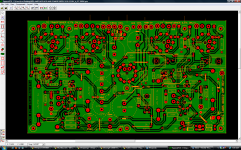
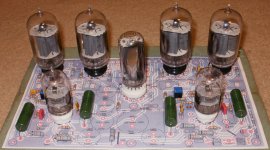
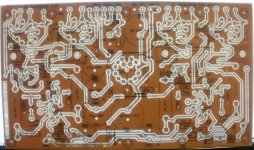
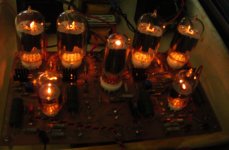
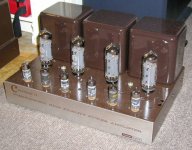
 yes to TV tubes,
yes to TV tubes, 